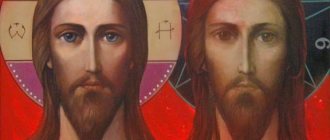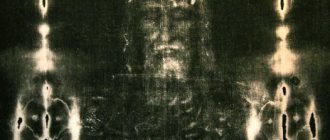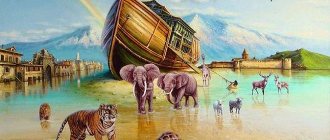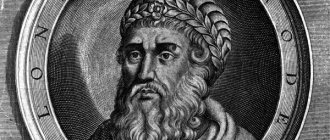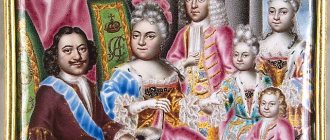Could Adam and Eve have had belly buttons?
The question of navels still does not have a clear answer; one still has to make reservations and go into discussions. Adam and Eve were the first people in the world, and they were created, not born, which means they should not have belly buttons. But why then are there belly buttons in paintings and icons? There are two common options:
First, there were no belly buttons, and their depiction was simply a mistake. After all, fine art is created by man, and he tends to make mistakes. This is often criticized and is slightly less popular than the second - the navel and were. Perhaps God considered this moment necessary to give a perfect appearance to his creations, and being the Almighty he brought his idea to life.
Adam was the FIRST FARMER
In Genesis 2:15 we read, “And the Lord God took the man and put him in the Garden of Eden to till it and keep it.” Adam, the first man, was commanded to work and tend the garden that God created.
It wouldn't be boring and tiring. For Adam this would be a joy. It was a perfect garden. There were no thorns and thistles, which appeared after God cursed the land. And since everything that God created was “very good” (Genesis 1:31), then Adam, and the plants, and the garden, and everything else had to be perfect.
How different the world has become today! How different gardening and farming have become today!
Hypotheses about the appearance of Adam and Eve
It is impossible to say exactly what Adam and Eve looked like. The first people were not black, but rather had a slightly dark skin tone - the kind that a person should have with minimal “jumps” of melanin. The hair was believed to be dark and the eyes were brown.
The age difference of the first people also causes active debate among people - recently they even put forward a theory that Adam was more than 2,000 years older, other sources gave figures tens of times higher - but this cannot be confirmed or refuted. It is impossible to know how old Adam was at the time of Eve's creation.
The theory that Eve gave birth at 800 years old was presented as convincing. This is wrong. It is impossible to say the exact ages, but here you can already use the Bible to guide you. “...Adam knew Eve” even before the exile, Seth was born when the man was only 130 years old, which means there is no talk of any eight hundred years.
It is also impossible to accurately determine the height of Adam and Eve, since the Bible did not give any figures. But scientists, based on indirect evidence, concluded that the growth of Adam and Eve was extremely high. The man is 37 m 73 cm, and the woman is 36 m 19.5 cm.
Why are we so different, but came from two people?
Because genes work differently, they are active in some places and not in others. Presumably , people would not be different from each other if Adam and Eve looked the same. But despite the similarity, we all know very well that man and woman were not the same.
If we further delve into the Biblical teaching and be more precise, then all people descended first from Adam and Eve, and then from Noah, his three sons and daughters-in-law - only they survived the flood. After some time, people began to build the Tower of Babel, which is why humanity began to speak different languages. During this period, there was a radical resettlement of the people, which led to such global differences.
There is only one race in the world - the human one, but modern culture requires division depending on appearance, place of residence, traditions, etc. The Bible allowed the division of the human race into 3 components, which descended from the previously mentioned sons of Noah:
Caucasian (Indo-European) race
This includes the entire “white” population of the world. Due to the different development of people in opposite corners of the world, this race forms the developed countries - Europe and North America.
Negroid (East African or Afro-Asian) race
All peoples of the Earth who are of African origin with black skin.
Semitic race
This includes Jews and other Semites.
The First Adam needed a "Last Adam"
God provided a second Adam—a perfect Adam who could be the perfect sacrifice. God Himself came down to earth in the form of a man.
Jesus Christ, the second person of the Trinity, was born of a woman in order to become a man so that the perfect sacrifice could be made. Jesus was God, but He was also a man, as God intended man to be—sinless. He was crucified on the cross of Calvary. He shed His blood and paid the price for our sins, overcoming death and the judgment that God placed on man because of sin.
1 Corinthians 15:26 says, “The last enemy that will be destroyed is death.” Death is swallowed up in victory, says Paul. And we can say with him: “Death, where is your sting? Hell, where is your victory? (1 Corinthians 15:55). Christ paid the price. The last Adam conquered death and provided a means of deliverance from the sin into which the first Adam fell, which led to separation from God.
Why shouldn't we fantasize about this topic?
Attitudes to fantasy in different aspects have different factors. You can fantasize, but subject to constant control. Nowadays, fantasies quite often take a person too far from reality, but this should not be the case. Moreover, religion discourages “magical” thinking, which accounts for most of the outcome of the imagination.
Regular fantasizing about whether there is a God, whether Adam and Eve were born or created, creates the risk of losing touch with faith. This is especially acute for children and adolescents, because they are quite young and, in the absence of proper religious education, can lose their beacons within.
What is the relationship between evolution and the creation of Adam?
“Why doesn’t the Bible say anything about dinosaurs, fish coming to land, and many other things that science studies? Is there a place for God in the history of life? What do the capricious twists and turns of evolution have in common with the six days of creation? Probably every Christian, and just any thinking person, has asked this question at least once.
What if, to answer it, it makes more sense to abandon the search for correspondence between the biblical account of the creation of the world and scientific data about the prehistoric past? - writes scientist Alexander Khramov in the book “Monkey and Adam”. We share an excerpt in which the author gives answers to these questions.
From the point of view of modern science, evolution is not just a theory, but a firmly established fact.
The common origin of living organisms is indicated by the features of their genetic code, embryonic development and anatomical structure. Even if we had no fossils at our disposal, there would be plenty of evidence for the existence of evolution. Beyond this evidence, however, paleontologists are unearthing more “missing links” every year that fill gaps in our knowledge of evolutionary history. For example, in 2004, a Tiktaalik fish was discovered in the Upper Devonian sediments of Canada, which combines the characteristics of fish and terrestrial tetrapods. The discovery of numerous feathered dinosaurs in China has shed light on the ancestry of birds. Monkey and Adam. Can a Christian be an evolutionist?
Alexander Khramov
425 RUR
But what if the Bible tells about the creation of the original, incorruptible world, and science studies a completely different reality - a world in a fallen state? Then it would be simply wrong to bring the first chapter of the Book of Genesis and scientific data about the prehistoric past to a common denominator. The fossil record is a string of graves. She cannot tell anything about a world where there was no death.
For example, if an archaeologist finds in Quaternary rocks a tooth of an ancient man or a stone chopper for cutting meat, does this find tell us anything about a creature that had no need for teeth or a chopper, since it did not need food? And this is exactly how, according to the Eastern Christian tradition, God created man.
Or, let's say, judging by molecular data, the exchange of genes between the ancestors of Homo sapiens and the ancestors of chimpanzees stopped about 10 million years ago. But what does this have to do with creatures that were not involved in sexual reproduction and therefore did not exchange genes with anyone? And then how can one see in the words “and the Lord God formed man from the dust of the ground” (Gen. 2:7) an indication of the origin of our species from lower animals, if we are talking here about a completely different - equal to the angels - state of being?
If we assume that man appears on the radar screen of science only in a fallen state, then speculating about his creation by appealing to archeology or genetics is like looking for angels using radar. When do we first meet ourselves on the pages of the book of nature? Let's rewind time 300 thousand years ago. Here we see the first anatomically modern people. Here they are digging through the carcass of some rancid antelope, here they are nursing a newborn by the fire, now one of them has become the prey of a lion. These dirty, half-naked creatures are least of all like “earthly angels” with a body free from corruption. Rather, before us are pathetic exiles from paradise.
Man, who arose in the course of evolution, is flesh from flesh and blood from the blood of animals. It is like a patchwork blanket, sewn from many scraps borrowed from other organisms. We inherited the genes responsible for intracellular metabolism from bacteria. The auditory ossicles in our middle ear are the remains of the gill arch of some fish from among our ancestors. We have monkeys to thank for their advanced color vision, which they used to find fruit under the canopy of the rainforest. With all the organs of our body, with all the features of our physiology, we are closely connected with the rest of the animal world. But the patristic tradition does not regard this as something normal - it sees man’s involvement in the life of animals as a consequence of the Fall.
Man has a history that goes beyond the animal kingdom, and the only place we can learn about it is the Bible.
At what point do two storylines intersect, one of which we find in the book of revelation, the other in the book of nature? At what point does the man in the biblical account of paradise become the man science studies? The Church Fathers have a clear answer to this question. Man from an angelic being turns into a biological organism at the moment when God places clothing made of animal skins on the exiles: “and the Lord God made clothing of skins for Adam and his wife and clothed them” (Genesis 3:21). In the patristic understanding of heaven, “leather vestments” are a symbol of everything that makes us similar to animals.
For early Augustine, leather vestments are also primarily a symbol of the animal existence to which people were doomed by the Fall. The most important manifestation of animality is Augustine, like St. Gregory of Nyssa, considered death: “what could more clearly mean the death that we experience in this body than the skins that we remove from dead animals.” The need to die makes us similar to animals, like the need to eat and reproduce: “he [man] fell to the mortality of animals.” Or, as St. writes. Maximus the Confessor, “sin, through disobedience, condemned people to have in common with dumb animals the property of succession from each other.” According to him, the Lord, immaculately born of the Virgin, comes to free people “from the bonds of birth and from [coming] because of the condemnation of sin, the law of growth from seed, like grass, and from becoming akin to plants and dumb animals in being.” .
A similar interpretation of this biblical image can be found in many of the Church Fathers. Before sin, man had no relation to the animal world, barking, neighing, bleating - this is what the Church Fathers tell us in different ways. Most likely, the animal world itself was completely different before the fall of man, before “the creation was subjected to vanity” (Rom. 8:20), but we don’t know what! From this point of view, the very inclusion of man in the evolving nature as a biological species, the fact that man “has become like foolish beasts” (Ps. 49:12) and traces his ancestry to animals, must be regarded as a punishment for the sin he had previously committed for outside the historical time of the present world.
Indeed, the biblical words about leather vestments suggest a previous biological process. The animal from which the skin was removed had to first be born and grow it on itself. Therefore, leather vestments can be considered a good symbol of evolution, during which the biological basis necessary for the existence of fallen man was gradually developed. And if God creates the first, immortal body for life in paradise personally, without any intermediaries, His hand itself crumples a pliable piece of clay, then the entire long cause-and-effect series, the result of which was the emergence of our mortal body, should be equated rather to the “tailoring” of leather robe According to the Providence of God, the Universe sews, stitch by stitch, that “clothing” in the vestments of which the exile from paradise must continue his existence.
The entire evolutionary process, at the end point of which man finds himself in the role of a biological species, can be interpreted as a transit from a paradise to a fallen state of being.
In the Book of Genesis, the “switching” between these two states is described in just three or four lines: “and the Lord God made for Adam and his wife garments of skin and clothed them... and the Lord God sent him out of the garden of Eden to till the ground from which he was taken.” (Gen. 3:21–23).
But nothing prevents us from thinking that events that happened instantly from the point of view of heavenly reality could take billions of years of earthly time. After all, the Concordists equate the six days of creation with the 13.7 billion years that have passed since the Big Bang. So why not assume that the Big Bang occurred after the catastrophe of the Fall, and the evolution of matter, culminating in the appearance of Homo sapiens, corresponds to the period of time between the placing of the leather vestments on Adam and Eve and the moment when they find themselves outside the Garden of Eden surrounded by thorns and thistles?
According to Eriugena, the original spiritual body, in which people existed in paradise and in which they will be resurrected, has not gone away after the Fall, it is only “hidden in a secret place of nature” and, waiting in the wings, is in another dimension of existence. The corruptible body was only added (superaddita). The added body, unlike the original one, is mortal and perishable; it exists in space and time. “The material and external body is like a garment, and is not without reason considered to be a sign (signaculum) [attached] to the internal and natural body, since it moves from age to age and in time, undergoing increase and decrease, while the internal body always remains unchanged "
Isn’t this idea reflected in the Byzantine and Old Russian icon painting canon? The human body is presented in icons not as it appears to the carnal eye. The figures of the holy saints are unnaturally elongated and stretched upward, frozen in emphatically static poses, alien to muscular effort. Disproportionally narrow shoulders and huge eyes create the impression of detachment from everything earthly. Meanwhile, the icons depict real people of flesh and blood. Here is the Great Martyr Panteleimon with a medicine box, here are Saints Boris and Gleb in princely hats trimmed with fur. But at the same time, the icon painter, as it were, looks behind the screen of external anatomy in order to show the true body of the saint, impassive and incorruptible, which is hidden among ordinary people.
At the end of time, says the Orthodox theology of the East, this outer shell, alien to our true nature, will be cast off so that man will finally appear in his pristine beauty. The contrast between the two states of corporeality is clearly seen in the example of the Son of God. Christian theologians have always seen His death and resurrection as an indication of the path that the rest of humanity must take. Having become incarnate, the Lord took on a mortal and corruptible body, subject to all the hardships and adversities that befell man in the fallen world. As Leontius of Byzantium pointed out, “The Lord was hypostatically united with such flesh as the damned [Adam] was clothed with after the Fall.” But this flesh died on the cross, and the Lord is resurrected in a transformed body, which is alien to all manifestations of animal nature.
The resurrected Christ no longer felt tired, did not experience hunger or thirst, and, in the opinion of St. John of Damascus, ate in front of his disciples solely in order to give them “assurance of the truth of His resurrection.” The body of the resurrected Christ, able to pass through closed doors, was “unchanging, impassive and subtle” - exactly the same as the body of all other people would later become when they returned to their original paradise state in resurrection.
It is enough to read the Gospel to understand that the resurrected Christ interacts with the corruptible world of things in a completely different way than before - the laws of space and time no longer constrain Him. As Benedict XVI noted, “After the resurrection, Jesus belongs to a sphere of reality that, under normal conditions, is inaccessible to our senses... He no longer belongs to the sensory world: He now exists only in the world of God, which means that He can only be seen when when He himself allows it.”
Hence the lack of recognition of the resurrected Jesus (see Luke 24: 15–31; John 20: 14–15) by Mary Magdalene and the disciples, who had previously seen Him every day. It testifies to the incommensurability of two planes of existence - the fallen world and the world where paradise remains and where the resurrection will take place. Christ is the firstborn from the dead, the firstfruits of the resurrection, which can only happen under different laws of nature. A universe that obeys these laws will not arise sometime later, billions of years later on the earthly time scale, it already exists, it was created by God in six days and has not disappeared anywhere. In the person of the resurrected Jesus, the invasion of this heavenly Universe into this world lying in evil takes place. We can say that we all join this parallel order of existence when, dying, we disappear into this world. “Today you will be with me in paradise,” Jesus said to the thief on the cross. In this world fallen time is still flowing, but in that world it has already been overcome, victory over death has already been won.
Read more about whether a Christian can be an evolutionist in the book
“The Monkey and Adam” by .
The main significance of the creation of man for the Orthodox
It is important to remember that everything around us belongs to the creator - even the smallest grain of sand. He gave us this world along with plants and animals, and now we can live.
Of course, it is impossible to cover the entire spectrum of interest, and this text is only a small grain of that information volume. But here it is important to remember - faith should always remain faith. You can and should be curious, but you shouldn’t look for evidence of what should be in your heart.
Rate this post
The following two tabs change content below.
- Author
- Latest articles
